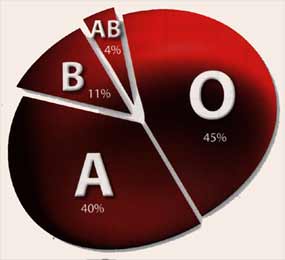  |
 |
|
||||||||||||||||||||||||||

In 1901, scientist Karl Landsteiner, reported that blood could be classified into blood "groups." By matching these blood groups, a successful blood transfusion could be made between a healthy donor and a patient in need of blood replacement due to an injury, disease or surgery. A blood transfusion can either be whole blood, or a blood component, such as red cells or platelets or plasma. Blood groups are based on specific proteins called antigens that are found on the surface of red blood cells, and antibodies found in plasma. Antibodies can recognize markers on foreign cells (those that are not the body's own cells). When the blood of two people mixes during a transfusion, the antibodies will act against any cells bearing the wrong marker. There are four basic blood groups:
If you are a Group A person, you do not carry antibodies against A markers. But you do have antibodies against Group B blood. If you are a Group B person, you have antibodies against Group A cells. If you are a Group O, you have antibodies against both Group A and B! The antibody reaction that occurs when two different blood groups
are mixed, causes the foreign red cells to be destroyed (hemolysis).
This can lead to kidney damage and death. That is why matching blood
groups between donor and patient is so important before a transfusion
is given. |
|
|||||||||||||||||||||||||
| Copyright 2002 - |

